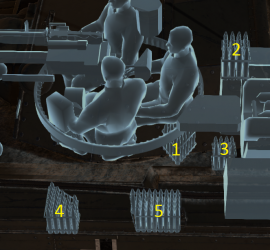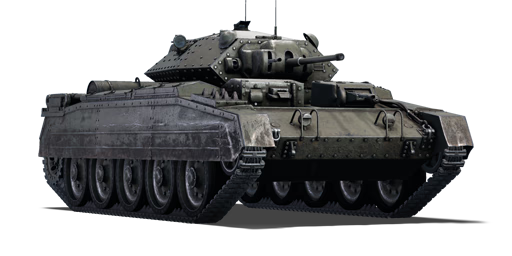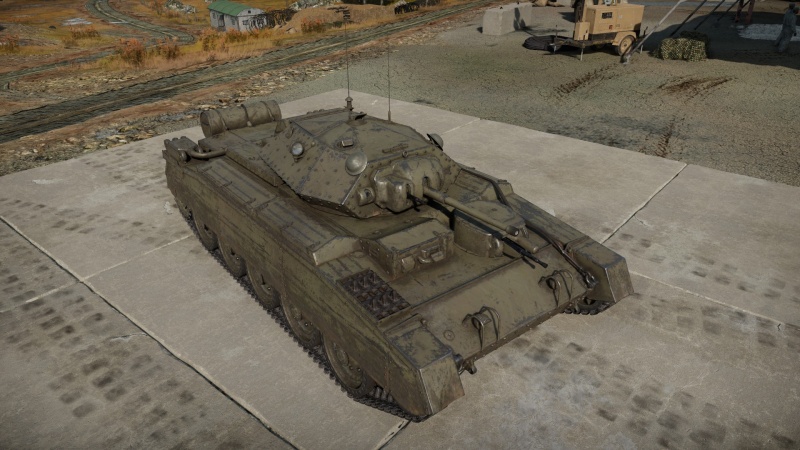Difference between revisions of "Crusader II"
(Updated format) |
(Edits) |
||
| Line 206: | Line 206: | ||
;Skins | ;Skins | ||
| − | + | * [https://live.warthunder.com/feed/camouflages/?vehicle=uk_crusader_mk_2 Skins and camouflages for the {{PAGENAME}} from live.warthunder.com.] | |
| − | * [https://live.warthunder.com/feed/camouflages/? | ||
;Videos | ;Videos | ||
| Line 220: | Line 219: | ||
''Paste links to sources and external resources, such as:'' | ''Paste links to sources and external resources, such as:'' | ||
* ''topic on the official game forum;'' | * ''topic on the official game forum;'' | ||
| − | |||
* ''other literature.'' | * ''other literature.'' | ||
{{Britain light tanks}} | {{Britain light tanks}} | ||
Revision as of 07:23, 25 September 2021
| This page is about the British light tank Crusader II. For other versions, see Crusader (Family). |
Contents
Description
The Tank, Cruiser, Mk VIA, Crusader II (A15) is a rank British light tank with a battle rating of (AB), (RB), and (SB). It was introduced along with the initial British ground tree in Update 1.55 "Royal Armour".
General info
Survivability and armour
Armour type:
- Rolled homogeneous armour
- Cast homogeneous armour (Gun mantlet, Machine gun mantlet, Driver's port)
- Structural steel (Side skirts)
| Armour | Front | Sides | Rear | Roof |
|---|---|---|---|---|
| Hull | 20 mm (33°) Front plate 9 mm (78-85°), 20 mm (61°) Front glacis 20 mm (27-64°) Lower glacis 18 mm (1°) Driver's port |
14 + 4 mm | 14 mm (44-51°) Top (14-51°) 14 mm Bottom |
7 mm |
| Main Turret | 30 mm (11°) Turret front 30 mm (6-58°) Gun mantlet |
14 mm (40-49°) | 17 + 12.7 mm (36°) Top 9 mm (66°) Bottom |
12.7 mm |
| Secondary Turret | 30 mm (1-32°) Turret front 20 mm (3-67°) Gun mantlet |
30 mm (1-3°) | 30 mm (5-6°) | 9 mm |
Notes:
- Suspension wheels and tracks are 15 mm thick.
Mobility
| Game Mode | Max Speed (km/h) | Weight (tons) | Engine power (horsepower) | Power-to-weight ratio (hp/ton) | |||
|---|---|---|---|---|---|---|---|
| Forward | Reverse | Stock | Upgraded | Stock | Upgraded | ||
| Arcade | Expression error: Unexpected * operator. | 527 | Expression error: Unexpected round operator. | __.__ | |||
| Realistic | 301 | Expression error: Unexpected round operator. | __.__ | ||||
Modifications and economy
Armaments
Main armament
| 40 mm QF 2-pounder | Turret rotation speed (°/s) | Reloading rate (seconds) | |||||||||||
|---|---|---|---|---|---|---|---|---|---|---|---|---|---|
| Mode | Capacity | Vertical | Horizontal | Stabilizer | Stock | Upgraded | Full | Expert | Aced | Stock | Full | Expert | Aced |
| Arcade | 110 | -15°/+20° | ±180° | Vertical | 34.27 | 47.44 | 57.60 | 63.69 | 67.76 | 3.64 | 3.22 | 2.97 | 2.80 |
| Realistic | 21.42 | 25.20 | 30.60 | 33.84 | 36.00 | ||||||||
Ammunition
| Penetration statistics | |||||||
|---|---|---|---|---|---|---|---|
| Ammunition | Type of warhead |
Penetration @ 0° Angle of Attack (mm) | |||||
| 10 m | 100 m | 500 m | 1,000 m | 1,500 m | 2,000 m | ||
| Shot Mk.1 AP/T | AP | 72 | 68 | 52 | 37 | 27 | 19 |
| Shot Mk.IXB APCBC/T | APCBC | 89 | 86 | 77 | 66 | 57 | 50 |
| Shot Mk.1 APHV/T | AP | 80 | 75 | 58 | 41 | 30 | 21 |
| Shell Mk.1 AP/T | APHE | 66 | 62 | 49 | 36 | 26 | 20 |
| Shell details | |||||||||
|---|---|---|---|---|---|---|---|---|---|
| Ammunition | Type of warhead |
Velocity (m/s) |
Projectile Mass (kg) |
Fuse delay (m) |
Fuse sensitivity (mm) |
Explosive Mass (TNT equivalent) (g) |
Ricochet | ||
| 0% | 50% | 100% | |||||||
| Shot Mk.1 AP/T | AP | 792 | 1.08 | N/A | N/A | N/A | 47° | 60° | 65° |
| Shot Mk.IXB APCBC/T | APCBC | 792 | 1.24 | N/A | N/A | N/A | 48° | 63° | 71° |
| Shot Mk.1 APHV/T | AP | 853 | 1.08 | N/A | N/A | N/A | 47° | 60° | 65° |
| Shell Mk.1 AP/T | APHE | 792 | 1.08 | 1.2 | 9 | 20.9 | 47° | 60° | 65° |
Ammo racks

| Full ammo |
1st rack empty |
2nd rack empty |
3rd rack empty |
4th rack empty |
5th rack empty |
Visual discrepancy |
|---|---|---|---|---|---|---|
| 110 | 89 (+21) | 67 (+43) | 45 (+65) | 23 (+87) | 1 (+109) | No |
Notes:
- Turret & center empty: 45 (+65) shells.
- Racks disappear after all shells in the rack have been shot or loaded.
Machine guns
| 7.92 mm BESA | ||||
|---|---|---|---|---|
| Mount | Capacity (Belt) | Fire rate | Vertical | Horizontal |
| Hull | 4,950 (225) | 600 | ±10° | ±50° |
| Coaxial | 3,375 (225) | 600 | N/A | N/A |
Usage in battles
The Crusader Mk II is a quite effective low-range light tank, it is equipped with a fast firing 40 mm cannon, which is excellent at taking out tanks with a cramped interior and the crew close to each other, very fast reload, gun stabilization and its good handling makes up for shell doing not so much damage.
Since it is a light tank it does not have much armour, driving and fighting in the open field should be avoided whatever it is possible, unless there is enough of cover or the terrain shaped in a way so it is possible to use the hull down tactics at which this tank excels at because of its very low profile. The tank also has excellent gun depression and the turret shape makes it hard to hit.
The combination of manoeuvrability, a great high speed, and good acceleration makes it good at flanking and rushing the enemy positions. Although its max speed may be lacking compared to other fast tanks such as the Stuarts or BTs, it is compensated by its acceleration. It can get to max speed very fast and the turning ability is very good at any speed, except for moving in the same place. Other than that tank is very stable and pleasant to drive.
Any frontal engagement with enemy SPAA units should be avoided, try engaging them only at a long distance, when flanking them, or with the Artillery upgrade (most SPAAs at the rank would have an open cabin so it is easy for artillery to kill their crews). Dealing with other light tanks should not be an issue. Although the 40 mm cannon lacks accuracy, its reload speed is fast and it should not be an issue hitting targets at a close distance. However, fighting against medium tanks and other bigger vehicles could be a problem, as its highly recommended to know the crew position in the enemy tank and where to aim for them. As for shell choice it is recommended to use the last unlockable shell, the Shell Mk. 1 AP/T, as it has more explosive filling that would help take out enemy crews more easily.
Pros and cons
Pros:
- 5 man crew
- Frontal armour can bounce the enemy shells when shot from certain angle
- High penetration 2 pdr cannon
- Low profile
- Very good acceleration with good handling
- Additional 4 mm side skirts
- Smoke grenades which can be fired one at the time
Cons:
- Overall weak armour
- Low maximum speed
- Most of shells have no explosive filler and can have trouble killing larger tanks, pinpoint shots are needed
- Crew is packed together, can be one-shotted easily by large calibre shells, notably the early Pz.IV models
- Flat surface on the front turret armour
- Any tank with a respectable gun will be able to penetrate and destroy the Crusader easily
History
Development
In 1938, the General Staff of the British Army requested for a cruiser tank that was lighter and more affordable than the heavier A16 cruiser design developed by Nuffield Mechanizations & Aero. One of these designs was the designation Tank, Cruiser Mk.V based off the A13 cruiser tanks, named the "Covenanter", and Nuffield was invited to become part of its development team, but they refused due to interest in developing their own cruiser tank. Their tank was designated the Tank, Cruiser Mk.VI Crusader and fell under the General Staff specification of A15. The Crusader was a parallel design to the Covenanter, but was ready six weeks earlier than the Covenanter despite starting at a later time. The Crusader was adopted into service with the British Army in 1941 and the 5,300 units were manufactured between 1940 to 1943.
Design
The Crusader features a new design that differs from its cruiser tank predecessors. The Christie suspension system on the Crusader had five road wheels for it instead of the usual four, which improves weight distribution of the increased 20 ton weight of the Crusader compared to the 14 tons of the A13 cruisers. The engine, steering system, and cooling system on the Crusader was different as well, but the Covenanter and Crusader use the same main turret. The polygonal shape of the turret gives the crew inside more room for the turret ring diameter.
The Crusader Mk.I and Mk.II were equipped with the 2-pounder, which was aimed by the gunner inside with a padded shaft that allows them to elevate the gun by simply adjusting his own height. Later in the war where an up-gun of the tank armament was necessary and newer tanks such as the Cromwell was delayed, the Crusader was upgraded into the Crusader Mk III variant with a 6-pounder instead, which restricted turret space, requiring the turret crew to be reduced from three to two. These saw first action the Second Battle of El Alamein in October 1942.
Combat Usage
The Crusader first saw action at North Africa, right after the British had been pushed back to the Egyptian border by Axis forces. The Crusaders were part of the huge shipment in the Malta Convoys to reequip the British forces there. Enough Crusaders arrive that the entire 6th Royal Tank Regiment was refitted with them, which joined up with the 2nd Royal Tank Regiment to form the 7th Armoured Brigade "Desert Rats". The brigade's first action was in Operation Battleaxe, though it was delayed due to adapting the tanks for the desert environment. The operation, which called for the relieve of the siege of Tobruk in June, was initiated in June to which 11 Crusader tanks were lost to anti-tank guns, plus many more to mechanical faults. While more Crusader tanks came in to reinforce the cruiser tank forces, there were never enough to supply the continuously expanding armoured units as 7th Brigade was combine with the 7th Hussars, the 2nd Armoured Brigade was added to the 7th Armoured Division, and the 8th Hussars was combined with the 4th Armoured Brigade. Overall, the Crusaders proved effective in the North African Campaign, the Crusader was faster than any tanks on the opposing side and the 2-pounder was lethal to the Panzer III, but the tank suffered from its thin armour, mechanical problems in the desert, and the growing deficiency of the 2-pounder, which didn't have enough range to destroy farther tanks. The Crusader design also caused the ammo racks on the tank to easily ignite due to unprotected racks and shot traps on the turret design. Anti-tank guns continue to be the main reason the Crusader units suffer losses, rather than to enemy tanks.
By the end of 1941, only the 2nd Armoured Brigade retained the Crusaders, the rest of the other tank units were being refitted with better tanks, such as the M3 Grant medium tank from the American Lend-Lease. Crusader units were also refitted with the more powerful Crusader Mk.III with the 6-pounder, which improved the Crusader's ability to destroy the gradually stronger German tanks. After General Bernard Montgomery took command of the British Army in 1942, more British tank units were reequipped with the Grant and M4 Sherman tanks while the Crusaders were relegated from the front-lines to "light squadrons" meant to flank the enemy and attacked at its exposed sides. When the British 1st Army engaged the Axis at Tunisia, some tank regiments still use Crusaders mixed in with Valentine tanks. These units in the 26th Armoured Brigade, code named "Blade Force", worked alongside the 78th Infantry Division as an independent armoured column. During Tunisia, the 1st Army was already converting the tank regiments into Shermans, but the 8th Army continued to use the Crusaders for much longer, which would see use at the Battle of Wadi Akarit and Mareth Line.
After the North African Campaign, the Crusaders no longer saw any use in the front-lines and were used in other roles such as gun tractors with 17-pounders or anti-aircraft mounts such as the Crusader AA Mk I and Mk II Some Crusader tanks equipped the tank regiments that stayed back at the British Homelands such as the 11th Armoured Division.
Survivors
About 21 Crusaders still exist intact in various parts of the world. The most notable places with the Crusaders are South Africa with 8 known survivors, a running Crusader Mk III at Bovington Tank Museum at England, and an anti-aircraft version at Musée des Blindés in France.
Media
- Skins
- Videos
See also
Links to the articles on the War Thunder Wiki that you think will be useful for the reader, for example:
- reference to the series of the vehicles;
- links to approximate analogues of other nations and research trees.
External links
Paste links to sources and external resources, such as:
- topic on the official game forum;
- other literature.
| Britain light tanks | |
|---|---|
| A13 | A13 Mk I · A13 Mk I (3rd R.T.R.) · A13 Mk II · A13 Mk II 1939 |
| A15 | Crusader II · Crusader "The Saint" · Crusader III |
| A17 | Tetrarch I |
| IFV | Warrior · Desert Warrior (Kuwait) |
| Wheeled | Daimler Mk II · AEC Mk II · Fox · Vickers Mk.11 |
| Other | VFM5 |
| South Africa | |
| SARC | SARC MkIVa · SARC MkVI (2pdr) · SARC MkVI (6pdr) |
| Ratel | Ratel 90 · Ratel 20 |
| Rooikat | Rooikat Mk.1D · Rooikat 105 · Rooikat MTTD |
| Other | Concept 3 · Eland 90 Mk.7 |
| USA | Stuart I · Stuart III |





